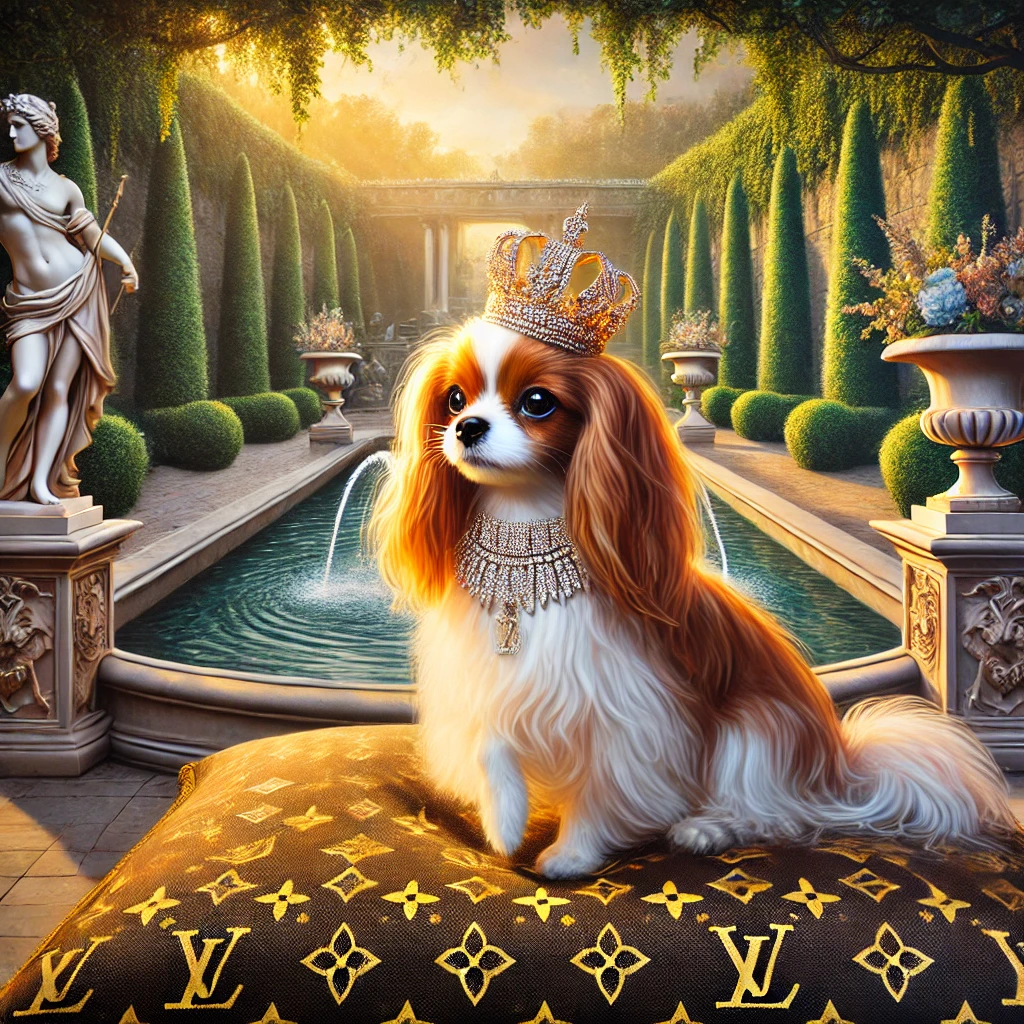Congratulations on your new Cavalier King Charles Spaniel puppy! Here are some essential tips to help you take the best possible care of your new companion and ensure they have a happy, healthy start in life.
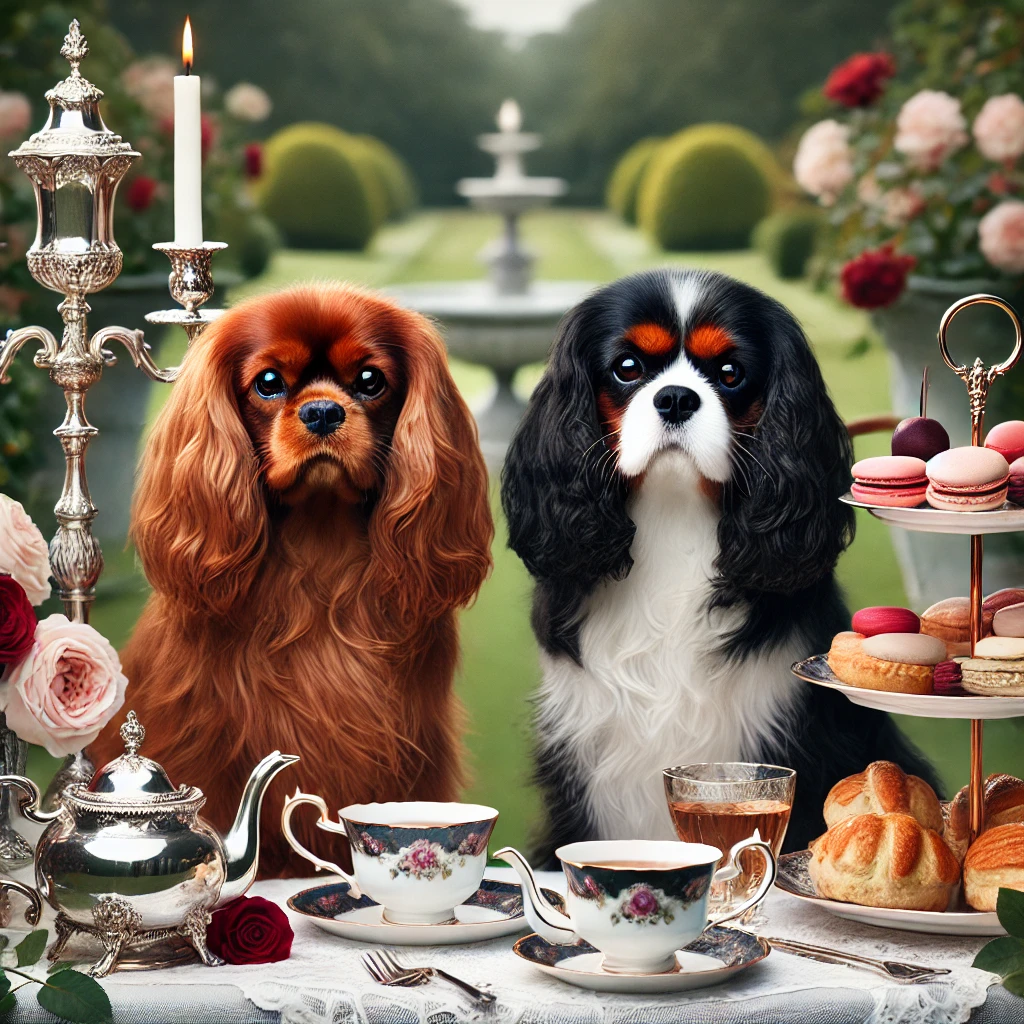
1. Prepare Your Home
• Puppy-Proofing: Remove small objects, cover electrical cords, and secure any toxic plants or chemicals within your puppy’s reach.
• Create a Safe Space: Set up a cozy, quiet spot where your puppy can relax, such as a crate or a small gated area with a comfortable bed.
2. Set a Routine
• Consistent Schedule: Stick to a regular feeding, potty, and sleep schedule to help your puppy feel secure and adjust faster.
• Potty Training: Take your puppy out frequently, especially after meals and naps, and praise them when they go outside to reinforce good habits.
3. Feeding Tips
• High-Quality Food: Choose a high-quality puppy food with balanced nutrients for small breeds. Avoid foods with fillers and artificial additives.
• Portion Control: Cavaliers can be prone to weight gain, so follow the recommended portion sizes of your breeder. Food packaging feeding guides can be misleading. Limit treats to training rewards.
4. Socialization
• Expose to New Experiences: Introduce your puppy to different people, places, sounds, and other pets early on. This helps prevent anxiety and promotes a confident, friendly dog.
• Puppy Classes: Once your puppy is vaccinated, consider joining a puppy socialization class where they can safely interact with other dogs.
5. Training Basics
• Start with Simple Commands: Begin training with simple commands like “sit,” “stay,” and “come.” Use positive reinforcement with treats, praise, and patience.
• Leash Training: Cavaliers can be curious, so practice leash training early to keep them safe on walks.
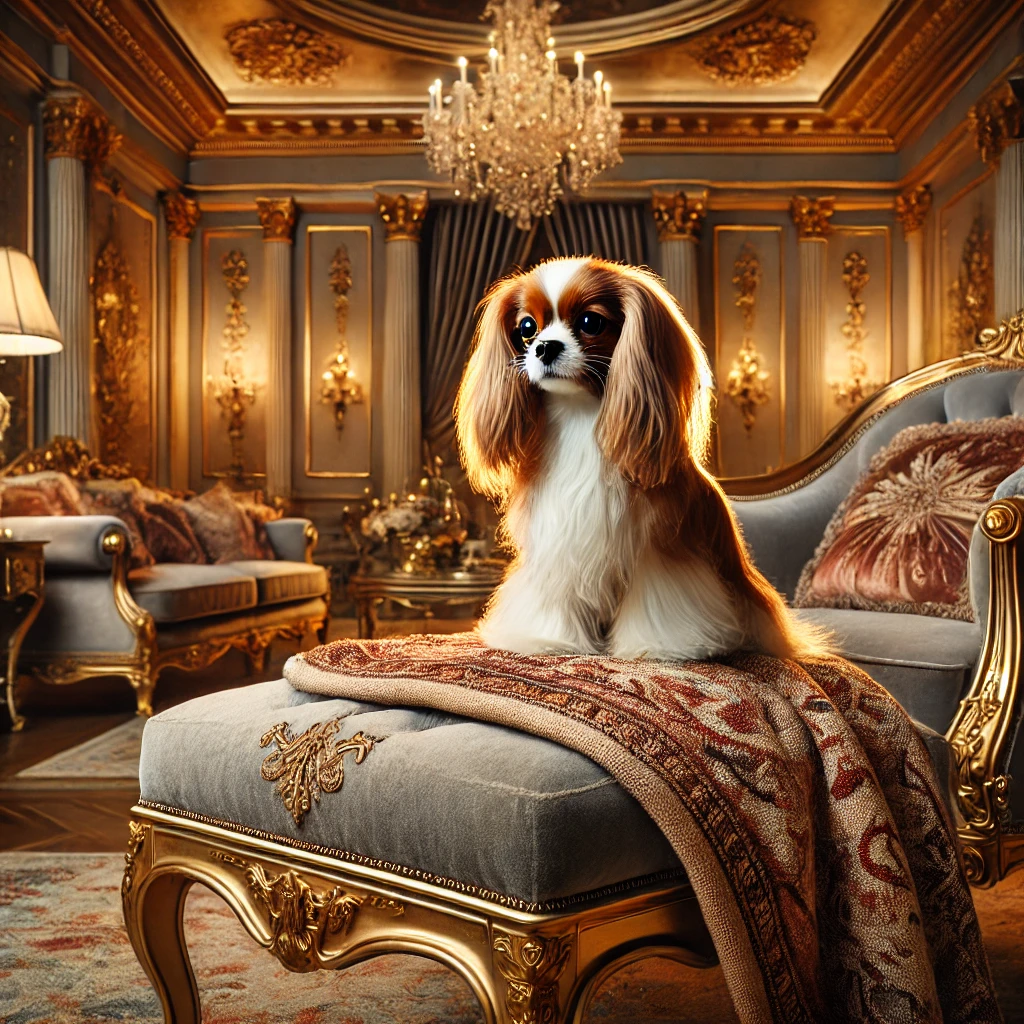
6. Grooming Care
• Brushing: Cavaliers have beautiful coats that need regular brushing (about 2-3 times a week) to prevent mats and tangles.
• Bathing and Ear Care: Bathe as needed, and check ears regularly for wax or signs of infection, as Cavaliers are prone to ear issues.
7. Exercise Needs
• Daily Activity: Cavaliers need daily exercise but don’t require vigorous activity. Short walks and gentle play are usually enough.
• Mental Stimulation: These dogs are intelligent, so engage them with puzzle toys, obedience games, or simple tricks to keep their minds active.
8. Monitor Health Closely
• Veterinary Checkups: Schedule regular vet visits to monitor your puppy’s growth and vaccinations.
• Be Aware of Common Health Issues: Cavaliers can be prone to certain conditions, including mitral valve heart disease. Keep an eye out for early signs and consult your vet regularly.
9. Show Lots of Love and Attention
• Cavaliers are affectionate, people-oriented dogs. They thrive on being close to their family, so include your puppy in daily activities, and don’t leave them alone for long periods.
10. Patience is Key
• Adjusting to a new environment can be overwhelming for puppies. Be patient, consistent, and gentle as they learn new skills and behaviors.
With these tips, your Cavalier King Charles puppy is well on their way to becoming a beloved member of your family. Enjoy this special time together!

Adjustment Tips: Young vs. Older Cavalier Puppies
At Lizmere, we match families with Cavalier King Charles Spaniel puppies at different ages—some as young as 10 weeks, and others a bit older. Each age brings unique benefits and needs, especially when it comes to transitioning into a new home.
10-Week-Old Puppies: Eager and Adaptable
Puppies placed at this age are in their early social development stage. Everything is new and exciting to them, and they tend to bond quickly with their new family members. Their flexibility makes the transition relatively easy, and they often settle into their new homes within just a few days.
Older Puppies: Thoughtful and Bonded
When placing an older puppy (typically 4 months and up), we remind new owners that these pups may take a little more time to adjust. They’ve had more life experience, have developed attachments with their littermates and caregivers, and may be more observant or reserved at first.
This is completely normal and simply a sign of emotional maturity. With time and trust, their loving and playful nature always shines through.
What to Expect from an Older Puppy
- May be quieter or shy at first
- Needs time to observe and feel safe
- Opens up gradually—often in just a few days or weeks
How to Support the Transition
- Give them space and time – Let them adjust at their pace
- Maintain a gentle routine – Predictability helps them feel secure
- Use quiet affection and encouragement – Cavaliers respond beautifully to love and patience
The Result? A Deep Bond for Life
Older Cavalier puppies often form exceptionally strong connections with their new families once they’ve had time to trust and settle in. The initial adjustment period is short-lived compared to the lifelong loyalty and love you’ll receive in return.
Questions about puppy ages or personality fit?
We’re happy to help guide you to the right match.

I would like to bring up a point that most dog owners must face when new puppies come home.
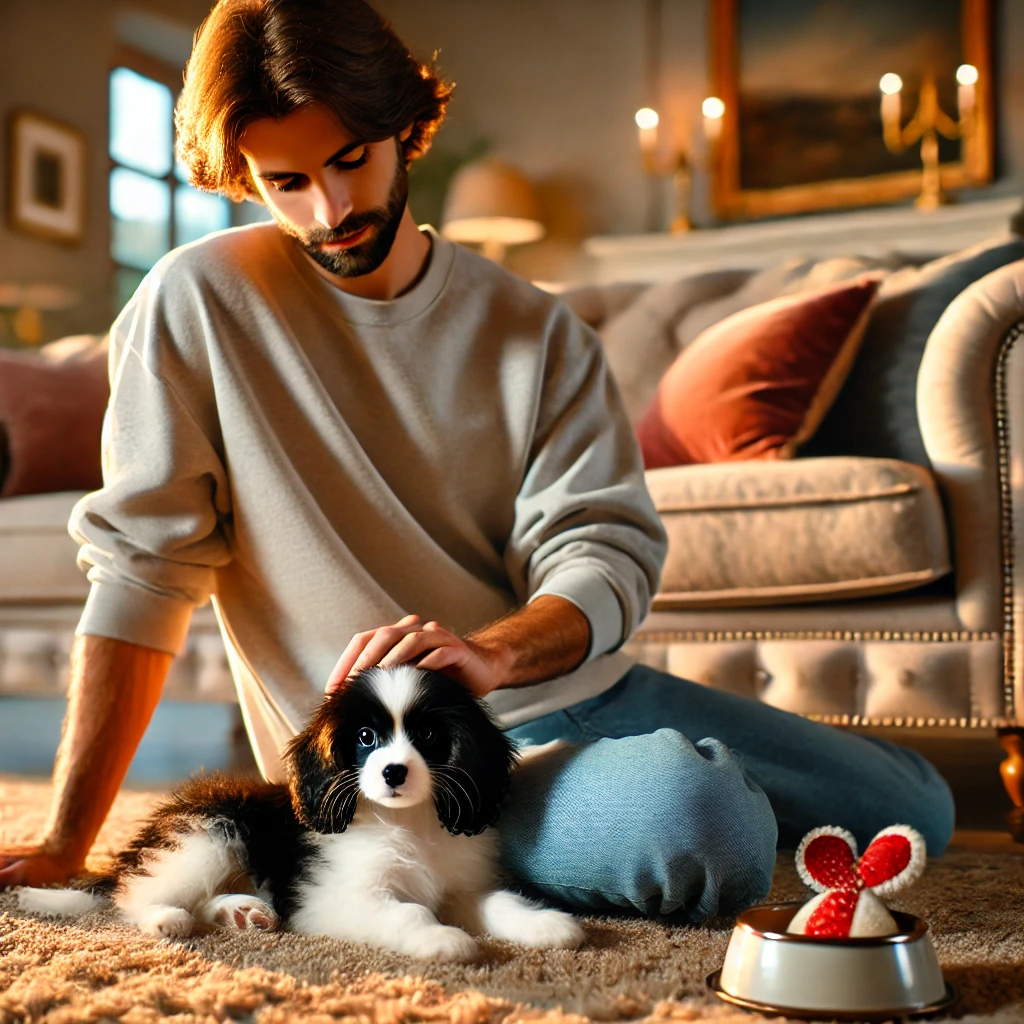
Realistic Expectations:
You’ve viewed still pictures and videos from the breeder where the puppies are social, calm, sweet, and playing happily with the pack. The breeder shows you clips of them being relaxed, joyful, and playful. Everything seemed perfect, as one would imagine, so you brought your puppy home with great eagerness.
Then comes the rude awakening. For the first nights, the puppy cries relentlessly, and you’re tired and irritable. The social, friendly puppy doesn’t want to meet all the enthusiastic friends you invited to meet your new friend or the loud, overexcited children in your home. It may detest walking on a leash. All of a sudden, you wonder how your dream puppy turned into a handful.
Let me speak to realistic expectations when bringing a puppy into your home.
First of all, consider the following: Up until now, your puppy’s life was at the breeder’s home with mom and littermates. They had a certain routine they were used to. The puppies felt safe, knew their surroundings, and even knew what was expected of them.
Now, put yourself in a completely foreign country where you know only a handful of words in its language. Everything is different: sounds, smells, weather, animals, people. Your routine has suddenly changed, and in this new place, you are expected to socialize or do tasks you don’t understand. Overwhelming, right?
That is what happens with every puppy upon transitioning to a new home. Stress can manifest in different ways: loss of appetite, not wanting to play or greet people, being nervous at the vet, and discomfort when approached by strangers. Other symptoms include diarrhea, vomiting, depression, and hypoglycemia.
Helping your new puppy adjust:
Most puppies take about 3-4 weeks to settle into a home. Say it with me now: THREE TO FOUR WEEKS—minimum! Heck, even longer! Not just one or two days. It takes some real time for a puppy to feel truly comfortable in a new home.
PLEASE limit visitors during the first two weeks. We know you are excited to share your new puppy with friends and family, but give them some time to adjust. It’s best to wait about 1 to 2 weeks before receiving guests.
Ask guests to remove their shoes in the entryway so they do not bring germs into your home that your sensitive puppy might pick up.
• Have them sit on the floor and wait for the puppy to come to them. NO squealing or reaching for the puppy, as that can be very scary.
• Develop a consistent routine.
• Restrict the puppy to a small area in the house. This reduces stress and lets you supervise them easily.
Don’t expect an 8 to 16-week-old puppy to walk well on a leash. Practice indoors where they feel secure. Let them drag the leash around to get used to it, and use treats to entice them into walking with you. Be patient if your puppy is hesitant to walk.
Also, keep in mind that your puppy needs time to bond with you and see you as family. You can’t expect an instant connection. They have to learn the structure of the family and feel secure.
• Training helps create a bond and teaches the puppy to look to you for guidance.
Puppies are young and fragile, and children can be a big stressor. Always supervise interactions and teach kids how delicate and easily scared the puppy might be.
Above all, BE PATIENT. Don’t assume there’s something wrong with your puppy. Progress takes time.
Outings should be gradual and only after vaccinations are complete. Move at your puppy’s pace. A long walk around the lake may sound fun to you, but your puppy might manage only a short distance. Observe and adjust based on their reactions. Walks can be time-consuming because I let puppies explore at their own pace. Patience is key!
If your puppy was thriving at the breeder’s but seems to struggle now, it’s your job to guide them. It takes time, training, and a positive attitude. Remember, every puppy is unique. Don’t compare your current puppy to previous pets or expect similar behavior. View things from your puppy’s perspective and adjust.
Love your puppy, and they will love you a hundredfold in return.

Ear Care
Caring for a dog’s ears, especially for a breed like the Cavalier King Charles Spaniel, involves a few special practices to maintain ear health and encourage growth.
1. Regular Brushing: Gently brush your dog’s ears daily with a soft bristle or pin brush to prevent matting and to encourage healthy growth. This also helps to stimulate blood circulation in the ear area, which can aid in hair growth.
2. Avoiding Breakage: Keep the hair soft and strong by using a leave-in conditioner designed for dogs. Human hair products can be too harsh, so look for gentle dog-specific options that nourish without weighing the hair down.
3. Diet and Supplements: Ensure your dog’s diet is rich in essential fatty acids, such as omega-3 and omega-6, which can help promote a shiny coat and potentially encourage ear hair growth. Some owners also supplement with biotin, but consult your vet before adding any new supplements.
4. Ear Health Maintenance: Regularly clean your dog’s ears with a vet-approved ear cleaner. This will help prevent infections, which can interfere with hair growth. Be gentle and avoid over-cleaning, which can irritate the ears.
5. Protective Ear Wraps (Snoods): When your Cavalier eats, you can use a snood to protect the ear hair from getting wet or dirty. Keeping the ears clean and free of food residue helps prevent matting and breakage.
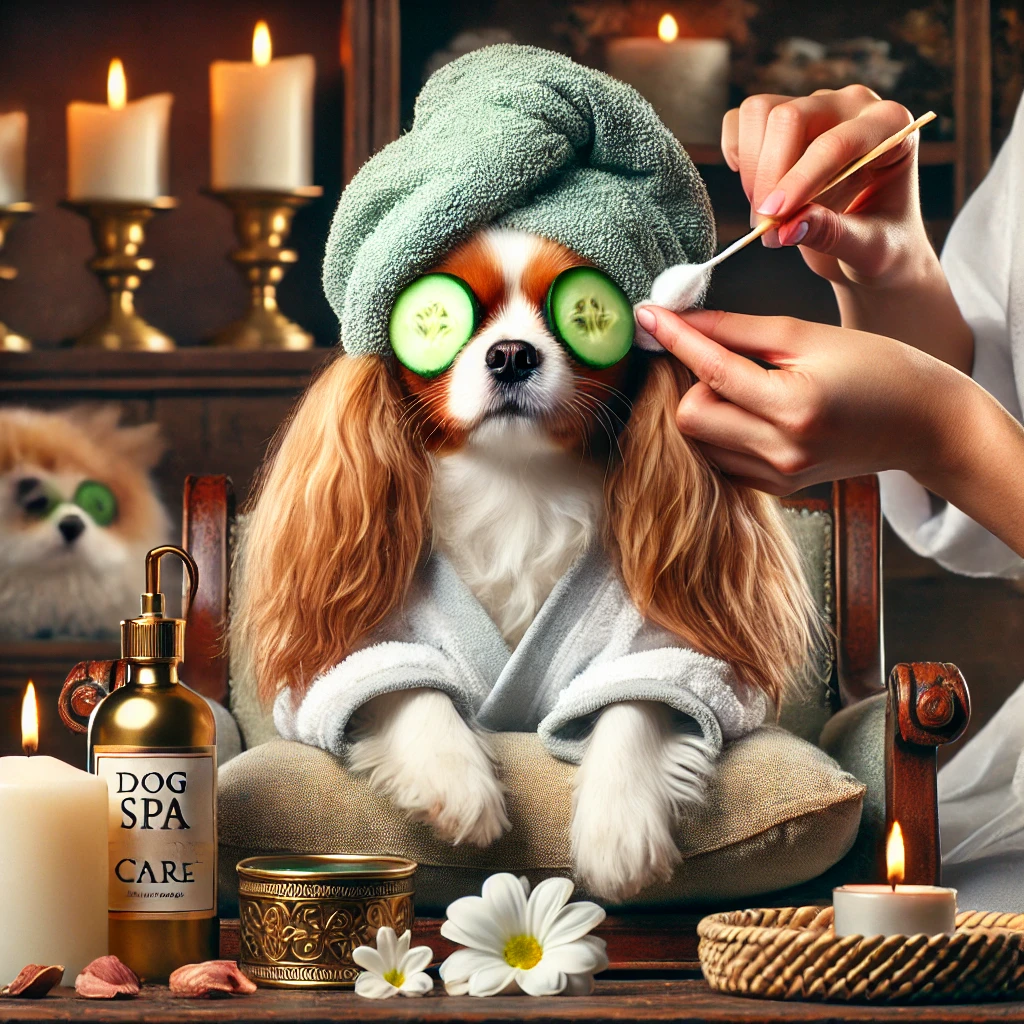
6. Minimizing Exposure to Friction: Encourage your dog to sleep on a soft surface like a satin pillowcase or a soft dog bed to reduce friction, which can cause hair breakage.
7. Professional Grooming: Consider working with a groomer familiar with show standards. They can help with ear trims that encourage length and volume without compromising growth.
Consistency with these steps can help promote healthier and potentially longer ear hair, contributing to your Cavalier’s overall show-ready appearance.

Socialization
Socialization training is a crucial part of raising a well-behaved and confident Cavalier King Charles Spaniel. Proper socialization helps them grow into friendly, adaptable adults who are comfortable in various situations and around different people and animals. Here is an in-depth guide on how to effectively socialize your Cavalier:
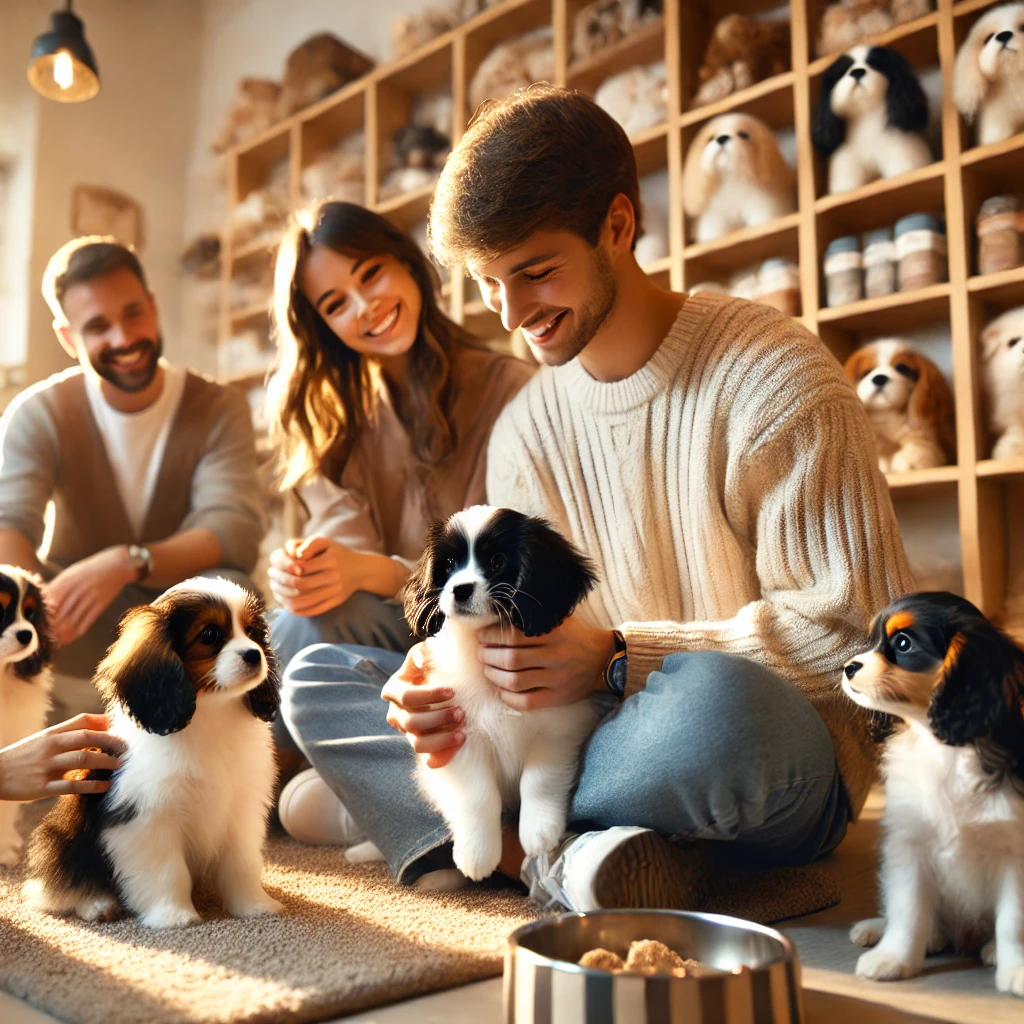
What is Socialization Training?
Socialization training is the process of gradually introducing your dog to new experiences, environments, sounds, people, and other animals. For Cavalier King Charles Spaniels, socialization is particularly important because they are naturally friendly, but without proper exposure, they can develop fear or anxiety in unfamiliar situations.
Why is Socialization Important?
• Prevents Anxiety and Aggression: Socialized dogs are less likely to become anxious or aggressive in unfamiliar environments.
• Builds Confidence: A well-socialized Cavalier is confident and less fearful of new experiences.
• Enhances Quality of Life: Cavaliers that are comfortable around people and animals enjoy outings, events, and family activities more.
• Facilitates Training: Dogs that are used to various stimuli are more receptive to training and are easier to manage.
When to Start Socialization
The best time to start socialization is during the puppy’s early developmental stage, usually between 3 and 16 weeks of age. However, if you adopt an older Cavalier, it’s never too late to begin; just take a more gradual and patient approach.
How to Socialize Your Cavalier King Charles Spaniel
1. Exposure to Different Environments
• Gradual Introduction: Start by taking your puppy to quiet, safe places like a friend’s home or a pet-friendly café. Gradually progress to busier environments like parks, markets, or city streets.
• Use Rewards: Encourage calm and positive behavior with treats and praise. Make each experience fun and rewarding.
2. Introducing People
• Variety of People: Expose your Cavalier to people of all ages, races, and appearances, including children, men with beards, people wearing hats, etc.
• Positive Associations: Ask new people to give your dog a treat. This helps your Cavalier associate meeting new people with something pleasant.
• Controlled Interactions: Ensure that the interactions are not overwhelming. If your dog seems nervous, give them space and try again another time.
3. Meeting Other Dogs and Animals
• Puppy Playgroups: Enroll your puppy in a well-monitored puppy class where they can interact with other vaccinated puppies in a controlled environment.
• Leash Walks: Take your Cavalier on leash walks where they may encounter other dogs. Let them observe first, and if both dogs seem friendly, allow a gentle, supervised greeting.
• Dog Parks: Once your Cavalier is fully vaccinated, you can try visiting dog parks. Always monitor your dog’s behavior and ensure that interactions remain positive.
4. Exposure to Various Sounds and Sights
• Household Noises: Get your Cavalier accustomed to everyday noises like the vacuum cleaner, dishwasher, or hairdryer. Play recordings of fireworks, thunderstorms, or city sounds at a low volume and gradually increase the volume over time.
• Objects and Surfaces: Introduce your dog to different surfaces like grass, gravel, tile, or carpet. This helps them become comfortable walking on a variety of textures.
5. Handling and Touch
• Gentle Handling: Regularly touch your puppy’s paws, ears, and mouth to get them used to being handled, which will help with future grooming and vet visits.
• Vet and Groomer Visits: Take your Cavalier to the vet or groomer just to say hello and get treats. This helps them associate these experiences with positive outcomes.
Tips for Successful Socialization
1. Stay Calm and Confident: Your dog can sense your emotions. If you are relaxed and positive, your dog is more likely to feel the same.
2. Pace Matters: Never force your Cavalier into a situation they find terrifying. Progress at a pace that your dog is comfortable with.
3. Watch for Signs of Stress: If your dog shows signs of stress, such as lip licking, yawning, cowering, or trying to escape, remove them from the situation and try again later at a lower intensity.
4. Use High-Value Treats: Special treats that your dog loves can make socialization experiences more enjoyable and rewarding.
5. Set Up Playdates: Arrange controlled playdates with friendly, vaccinated dogs to help your Cavalier learn proper dog etiquette.
Troubleshooting Common Socialization Challenges
• Fear of Strangers: If your dog is wary of strangers, have new people toss treats near them without making direct eye contact. Let your dog approach on their own terms.
• Nervous Around Dogs: Use distance as a training tool. Start with your Cavalier observing other dogs from afar and gradually decrease the distance over time.
• Overexcitement: If your Cavalier becomes too excited, practice calming techniques like sitting and focusing on you. Reward calm behavior.
Ongoing Socialization
Socialization is not a one-time event; it’s a lifelong process. Continue to expose your Cavalier to new experiences throughout their life to keep them well-adjusted and happy. Even as adults, regular exposure to new situations can prevent the onset of anxiety or fear-based behaviors.
By following these steps and maintaining a patient, consistent approach, you can raise a happy, confident, and well-socialized Cavalier King Charles Spaniel.

Potty Training
Potty training a Cavalier King Charles Spaniel, like any breed, requires patience, consistency, and positive reinforcement. Cavaliers are known for their affectionate nature and eagerness to please, which can make them responsive to training when approached the right way. Here are some essential tips to help ensure successful potty training:
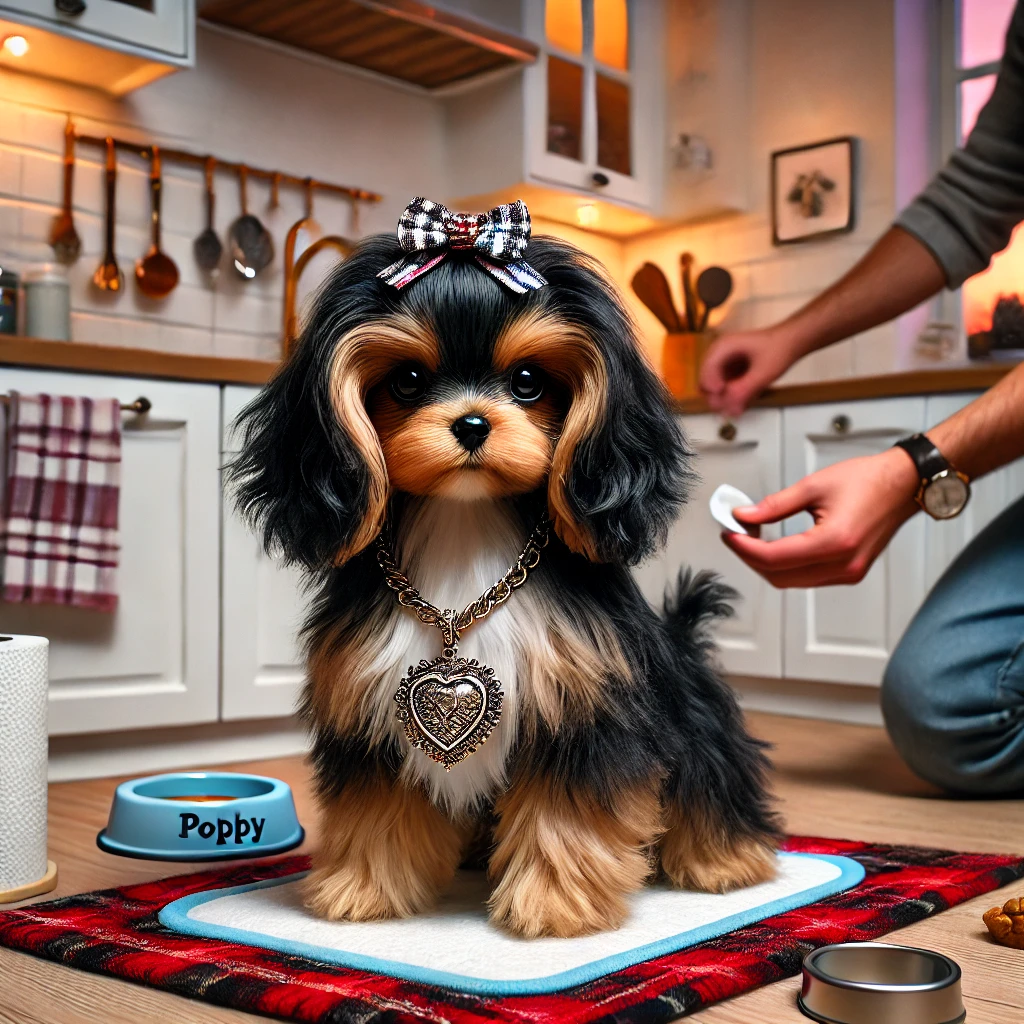
1. Start Early and Be Consistent
• Begin potty training as soon as you bring your puppy home. The earlier you start, the quicker they’ll learn.
• Set a regular schedule for feeding, bathroom breaks, and exercise. A routine helps them understand when and where to go.
2. Use Positive Reinforcement
• Reward your Cavalier immediately after they successfully go potty outside. Use treats, praise, and affection to reinforce the behavior.
• Avoid punishment or scolding for accidents, as this can create fear and confusion. Focus on rewarding good behavior.
3. Pick a Designated Spot
• Choose a specific spot in your yard for potty breaks, as the scent will encourage them to go in the same place every time.
• Lead them to this spot on a leash at first to reinforce the location.
4. Supervise and Limit Freedom Indoors
• Keep a close eye on your puppy when indoors. Watch for signs like sniffing, circling, or whining, which can indicate they need to go.
• Consider using baby gates or playpens to limit their access around the house until they’re fully trained.
5. Establish a Routine for Bathroom Breaks
• Take your puppy out first thing in the morning, after naps, after meals, and before bedtime. Puppies need frequent breaks, generally every 1-2 hours initially.
• Older dogs may need fewer breaks, but sticking to a routine helps them learn quickly.
6. Crate Training
• Use a crate as a safe and comfortable space for your puppy when you can’t supervise. Dogs naturally avoid soiling their sleeping area.
• Crates should not be used as punishment and should be the right size – enough for them to stand, turn around, and lie down comfortably.
7. Use a Command Cue
• When you bring your Cavalier to their potty spot, use a consistent cue like “Go potty” or “Do your business” to signal what you expect.
• With time, they’ll associate the phrase with the action, making it easier for them to understand what you want.
8. Handle Accidents Calmly
• If your puppy has an accident, clean it up thoroughly to remove any lingering odor, which can attract them to go in the same spot again.
• Use enzymatic cleaners specifically designed for pet messes, as they break down odor-causing bacteria effectively.
9. Be Patient and Persistent
• Every dog learns at their own pace, so be patient and don’t get discouraged. Cavalier King Charles Spaniels are known to be sensitive, so your tone and attitude during training are crucial.
• Celebrate small victories and acknowledge that setbacks are normal.
10. Stay Attuned to Their Signals
• As your Cavalier grows, they may naturally start showing signals when they need to go outside, such as barking, pawing at the door, or looking at you intently. Pay attention to these signs and respond quickly.
11. Consider Puppy Pads or Indoor Alternatives (if necessary).
• If you live in an apartment or an area with harsh weather, puppy pads or indoor dog potties can be a practical solution. However, if you use pads, keep them in a consistent spot and try to transition to outside as your puppy grows.
12. Monitor Their Progress and Adjust
• Some Cavaliers might take longer to fully potty train than others. Track their progress and adjust the schedule or methods as needed.
By following these tips with patience and care, you’ll set your Cavalier King Charles Spaniel up for potty training success.

Crate Training
Crate training your Cavalier King Charles Spaniel can be an effective way to create a safe, cozy space for them while helping with potty training and minimizing destructive behavior. Cavaliers, being naturally affectionate and eager to please, can respond well to crate training when approached with positive reinforcement and consistency. Here are some effective tips to help you crate train your Cavalier King Charles Spaniel:
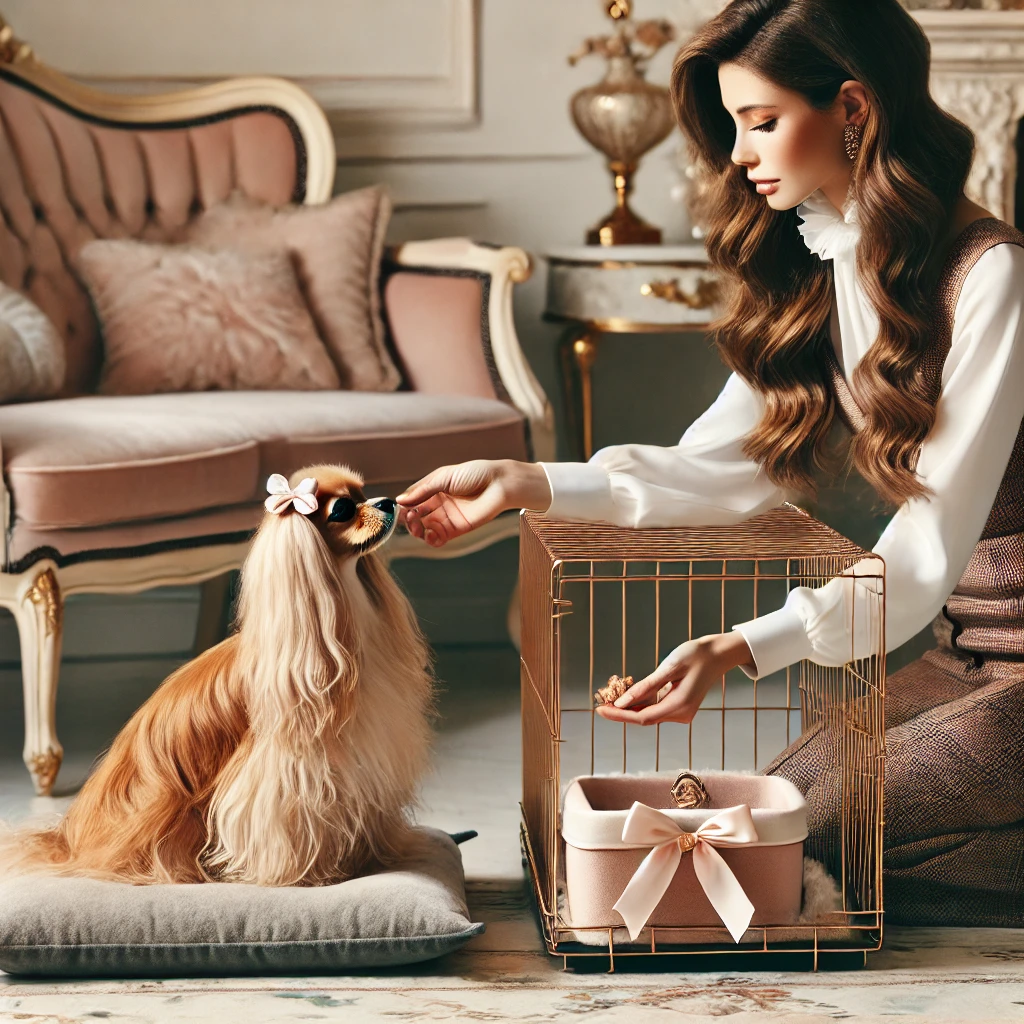
1. Choose the Right Crate
• Size Matters: Select a crate that is big enough for your Cavalier to stand up, turn around, and lie down comfortably. Avoid oversized crates, as too much space may encourage them to use one corner as a bathroom.
• Comfort is Key: Add soft bedding or a blanket inside the crate to make it cozy and inviting. Consider a chew-proof bed if they are still in the teething phase.
2. Introduce the Crate Gradually
• Create Positive Associations: Place the crate in a room where you spend a lot of time, like the living room. Open the door and let your Cavalier explore it on their own, without forcing them inside.
• Make it Inviting: Add some toys, treats, or a chew bone inside the crate to encourage them to step in and investigate. Let them associate the crate with positive things.
3. Use Treats and Rewards
• Encourage Voluntary Entry: Each time your Cavalier enters the crate, offer a treat and praise them. Repeat this a few times to help them feel that good things happen when they go inside.
• Reward Staying Inside: Start rewarding them for staying in the crate with the door open. Gradually, increase the time they stay inside with the door open before offering treats.
4. Start Closing the Door Briefly
• Short Intervals at First: Once they are comfortable going into the crate, close the door for a few seconds, then open it and reward them with a treat. Gradually increase the duration of the door being closed.
• Don’t Leave Immediately: When you first close the door, stay close by to prevent anxiety. As they adjust, you can step away for short periods to build their confidence in being alone.
5. Create a Calm, Quiet Environment
• Avoid Loud Sounds: When they’re in the crate, keep the area around it quiet and free from loud or sudden noises that might startle them.
• Add Soothing Elements: Some Cavaliers respond well to calming elements, like a ticking clock or soft music, which can soothe them, especially if they’re prone to separation anxiety.
6. Establish a Crate Routine
• Set Regular Crate Times: Put them in the crate for naps or quiet time throughout the day so they get used to it as part of their routine, not just when you’re leaving.
• Bedtime Routine: Use the crate as a designated sleeping space at night. Place the crate in your bedroom at first, so they can sense your presence nearby, reducing any feelings of isolation.
7. Encourage Calm Behavior in the Crate
• Ignore Whining (Unless They Need to Go): Some Cavaliers may whine or bark initially. Avoid responding right away, as this can reinforce the behavior. However, if you think they need a potty break, take them outside quietly and then return them to the crate.
• Reinforce Quiet Behavior: When they’re calm and quiet, offer praise or a small treat to reinforce this relaxed behavior in the crate.
8. Avoid Using the Crate as Punishment
• Keep It Positive: Never use the crate as a form of punishment, as this can create a negative association and increase resistance to going inside.
• Maintain a Consistent Tone: Ensure your Cavalier views the crate as a safe and positive place. Use a calm, reassuring tone when guiding them to their crate.
9. Gradually Increase Alone Time in the Crate
• Short Absences at First: Start by leaving them in the crate while you leave the room for a few minutes. Gradually extend this time to help them get used to being alone.
• Return Calmly: When you come back, avoid making a big fuss. This helps them learn that being alone in the crate is a normal, safe experience.
10. Establish Bathroom Breaks Around Crate Time
• Bathroom Before Crating: Take them outside for a potty break right before placing them in the crate, especially if they’ll be in there for a longer period.
• Regular Breaks for Puppies: Puppies generally need a potty break every 2-4 hours, depending on their age. Avoid crating them for longer periods without a bathroom break.
11. Use the Crate During Short Departures
• Start with Short Outings: Once they’re used to the crate, try leaving the house briefly while they’re in the crate. This helps them get used to the crate being their safe space when you’re away.
• Limit Crate Time: Avoid crating them for extended periods during the day. If you’re away for more than a few hours, consider alternatives like a pet sitter or dog walker.
12. Be Patient and Persistent
• Progress at Their Pace: Every dog is unique, and Cavaliers can be sensitive. Adapt your training to their comfort level, and don’t rush the process.
• Celebrate Small Wins: Consistently acknowledge calm, positive behavior in the crate. This will help your Cavalier feel safe, comfortable, and happy in their crate.
With patience, positivity, and consistency, your Cavalier King Charles Spaniel will soon see their crate as a welcoming and cozy space.

